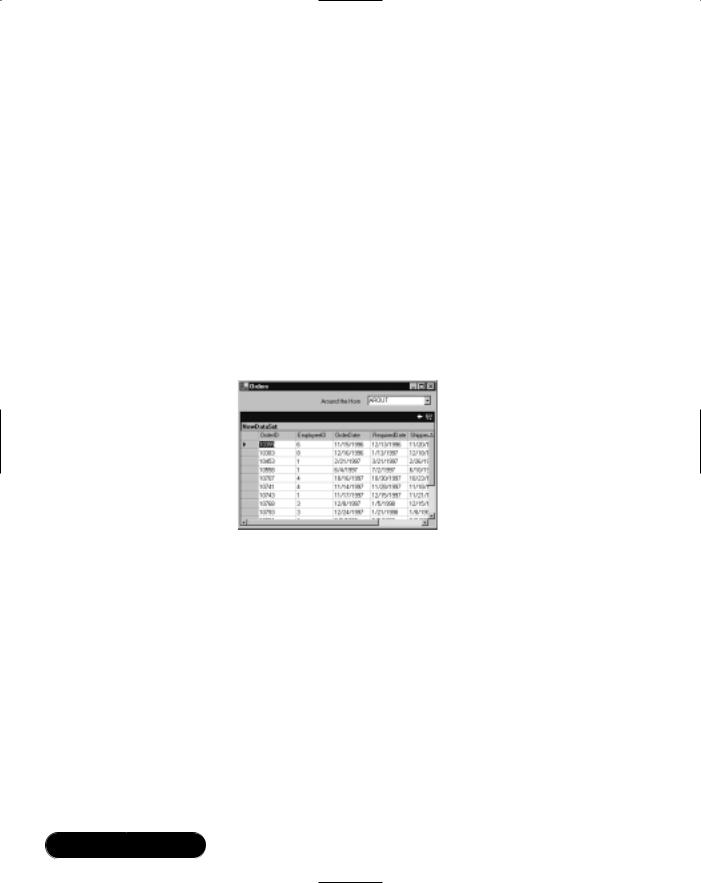

Chapter 8
ADO.NET
Solutions in this chapter:
■Introducing ADO.NET
■Working with System.Data.OleDb
■Working with SQL.NET
■Working with Odbc.NET
;Summary
;Solutions Fast Track
;Frequently Asked Questions
383

384 Chapter 8 • ADO.NET
Introduction
ADO.NET is the latest implementation of Microsoft’s Universal Data Access strategy. In the past few years, classic ActiveX Data Objects (ADO) has gone through many changes, bug fixes, and enhancements.These libraries have been the foundation for many Web sites and applications that are in place today. ADO.NET will be no different in this respect because Microsoft is positioning ADO.NET to be the primary data access technology for the .NET Framework. This will ensure that the Data Access Architecture is mature and robust because all the Common Language Runtime (CLR) languages will be using ADO.NET for their primary means of communicating with data providers.
Flexible and efficient data access technologies are at the heart of dynamic Web sites and Web applications. Classic ADO serialized data in a proprietary protocol that limited its reach, and it could have been made more efficient. ADO.NET serializes data using XML.This allows ADO.NET to take advantage of a standards-based approach to moving data back and forth in your applications. With rich support for any data source that can create or consume XML, ADO.NET is truly the data access technology for current and future applications. Through ADO.NET, you are able to connect to myriad data sources with the speed and flexibility that today’s businesses require.
The goal for the developers of the ADO.NET architecture was to continue the tradition of ADO by further removing the complexities of interacting with different data providers and shielding you from the intricacies that would interfere with your primary mission: packing functionality and usefulness into your applications. After this chapter, you should feel comfortable with connecting, viewing, and editing data using ADO.NET in the .NET Framework.
Introducing ADO.NET
To start with, let’s talk about the foundation. ADO.NET is based on XML, so you have rich support for XML documents. Classic ADO had some support later on for XML, but the format was difficult to use unless you were exchanging it with another ADO client.The ADO.NET objects are consistent with the XML specification and are well-defined. It is possible to take a plain XML document with just a root node and open it in ADO.NET, add data to it, and save it back out. Pretty handy for persistence.
The ADO Recordset is dead. ADO.NET has a couple of new ways to serve data, which made the Recordset obsolete. In classic ADO, the Recordset object was a
www.syngress.com

ADO.NET • Chapter 8 |
385 |
representation of a database cursor.You could open a Recordset, navigate forwards and backwards, change data, and leave it open. Leaving the Recordset open, however, would result in wasting resources on the database server.This was undesirable. In classic ADO, you could disconnect a Recordset and even save the Recordset to disk; however, updating a disconnected Recordset was difficult. ADO.NET has two options that work together to replace the Recordset: DataSet and the
DataReader.
You can think of the DataSet as an in-memory relational database. It has provisions for multiple tables, relations within the DataSet, primary keys, views, sorting—the list goes on. Classic ADO has no counterpart to the DataSet.The DataSet is not connected to the data source and holds a copy of the data that is put into it from the data source.You can populate a DataSet from any .NET provider, and you can save the contents back to any .NET provider.
The DataSet requires a DataAdapter.The DataAdapter represents the connection and commands to “fill” the DataSet. After the user is finished adding or updating the DataSet, the Update method of the DataAdapter is called and the changes are committed back to the data source. A couple of notes here; changes are not required to be committed back to the original source, and you can transfer data to another data source as long as the schema’s match.The other thing to keep in mind, especially when developing for ASP.NET, is that this is a disconnected copy of your data. It is suitable for a small subset of the data from your data source. For ASP.NET, a possible use would be for a small amount of data that needs to be retrieved more than once in the same page rendering, or that will not change in the course of a user’s session. For example, consider a Web application that has a drop-down list that contains the 50 states in the United States of America. If more than one of these is used on a page, a DataSet could be filled and every instance of the drop-down list is bound to this DataSet.This way, a database connection is created and used once for all 50 states and the results can be reused.
You can think of the DataReader as a fire hose recordset. A fire hose recordset was a nickname given to a read-only, forward-only Recordset in classic ADO. So, a DataReader is a forward-only, non-updateable stream of data from the data provider. For ASP.NET work, this is the object that is most useful. Because Web development is stateless, fast access to the data is more important than scrolling and updating. Another noteworthy item is that the DataAdapter uses a DataReader to populate a DataSet.
The next item we want to discuss is the idea of Managed Providers.A Managed Provider is a namespace designed to connect to—and execute commands
www.syngress.com

386 Chapter 8 • ADO.NET
against—a data source.A good example is the SqlClient Managed Provider.This namespace is written specifically to connect to Microsoft SQL Server.ADO.NET can be separated into two fundamental architectures, the first being the data “containers,” and the second being the Managed Providers. Data containers are the DataSet, DataTable, and DataReader objects.The objects are data-source-agnostic in that they do not contain any code specific to a data source.They do not really care where the data comes from—they are generic in nature.
Managed Providers, on the other hand, are specific to a data source. ADO.NET implements Managed Providers using different namespaces for the different data providers. In classic ADO, the Provider Property dictated the data source you were connecting to. For example, Microsoft Access would take a provider of “Microsoft.Jet.OLEDB.4.0”. For SQL Server, it was “SQLOLEDB.1”.
So, for example, this code:
Dim oConn as ADODB.Connection
SET oConn = New ADODB.Connection oConn.Provider="SQLOLEDB.1"
becomes
SqlConnection oConn;
oConn = new SqlConnection(strConn);
More commonly, the Provider property was another parameter in the Connection string.The Provider property is still used in the OleDb, and the Open Database Connectivity (ODBC) namespaces, however, the SqlClient namespace does not use a Provider property, and if the Provider property is left in the Connection string for a SqlConnection object, the object will throw an exception. Connection strings are discussed in detail later in the chapter.
ADO.NET Architecture
ADO.NET is the latest extension of the Universal Data Access technology. Its architecture is similar to classic ADO in some respects, but a great departure in others. ADO.NET is much simpler, less dependent on the data source, more flexible, and the format of data is textual instead of binary.Textual formatted data is more verbose than binary formatted data, and this makes it comparably larger. The tradeoff is ease of transportation through disconnected networks, flexibility, and speed.
www.syngress.com

ADO.NET • Chapter 8 |
387 |
Because data in ADO.NET is based on XML, Managed Providers are required to serve data in a proper XML format. Once a developer has written data access code, they only need to change a few parameters to connect to a different data source.
ADO.NET is based on a connection-less principle that is designed to ease the connection limitations that developers have traditionally had to deal with when creating distributed solutions.You no longer need to maintain a connection, or even worry about many of the connection options that developers had to deal with in the past.
Because the ADO.NET classes inherit from the same core of data access classes, switching data sources is much easier and less troublesome.Table 8.1 shows the core ADO.NET namespaces.
Table 8.1 ADO.NET Core Namespaces
Namespace |
Description |
|
|
|
|
System.Data |
Makes up the core objects such as DataTable, |
|
|
DataColumn, DataView, and Constraints. This |
|
|
namespace forms the basis for the others. |
|
System.Data.Common |
Defines generic objects shared by the different |
|
|
data providers such as DataAdapter, |
|
|
DataColumnMapping, and DataTableMapping. |
|
|
This namespace is used by data providers and con- |
|
|
tains collections useful for accessing data sources. |
|
|
For the most part, you do not use this namespace |
|
|
unless you are creating your own data provider. |
|
System.Data.OleDb |
Defines objects that you use to connect to and |
|
|
modify data in various data sources. It is written as |
|
|
the generic data provider, and the implementation |
|
|
provided by the .NET Framework in Beta2 contained |
|
|
drivers for Microsoft SQL Server, the Microsoft OLE |
|
|
DB Provider for Oracle, and Microsoft Provider for |
|
|
Jet 4.0. This class is useful if your project connects to |
|
|
many different data sources, but you want more |
|
|
performance than the ODBC provider. |
|
System.Data.SqlClient |
A data provider namespace created specifically for |
|
|
Microsoft SQL Server version 7.0 and up. If you are |
|
|
using Microsoft SQL Server, this namespace is |
|
|
written to take advantage of the Microsoft SQL |
|
|
Server API directly and provides better performance |
|
|
than the more generic System.Data.OleDb name- |
|
|
space. |
|
|
|
|
|
Continued |
|
www.syngress.com

388 Chapter 8 • ADO.NET
Table 8.1 Continued
Namespace Description
System.Data.SqlTypes Provides classes for data types specific to Microsoft SQL Server. These classes are designed specifically for SQL Server and provide better performance. If you do not use these specifically, the SQLClient objects will do it for you, but may result in loss of precision or type-conversion errors.
System.Data.Odbc This namespace is intended to work with all compliant ODBC drivers. It is available as a separate download from Microsoft.
The Command, Connection, DataReader, and DataAdapter are the core objects in ADO.NET.They form the basis for all operations regarding data in .NET.These objects are created from the System.Data.OleDb, System.Data.SqlClient, and the System.Data.Odbc namespaces.
Understanding the Connection Object
Making a database connection in ADO.NET is really very simple.The most difficult part of creating the connection is the Connection string.This is a semicolondelimited string of name-value pairs. If you have worked with ODBC, or even OLE-DB, they are basically the same with a twist for the SqlConnection object. Because the only acceptable data source that the SqlConnection object can connect to is Microsoft SQL Server, you do not need to specify a provider, it is understood that SQL Server is the data provider.
It has become common to create what is referred to as the DAL, or Data Access Layer.This implies a multitiered approach to application architecture, and ADO.NET lends itself quite well for this purpose. Because the System.Data namespace doesn’t really care about the data source or connection, the data container objects such as the DataSet can be populated from any provider that can understand how to connect between them and the data source. So, if a developer has a page level DataSet, it can be populated from an OleDbDataReader object, or the SqlDataReader object.The data source can be decided at runtime if the application requires it.
Each Managed Provider implements a connection object which is specific to the data sources it will connect to.The OleDb Managed Provider is specifically written to connect to a data source that understand the OLE-DB protocols.The same can be said for the ODBC, and SqlClient Managed Providers.
www.syngress.com

ADO.NET • Chapter 8 |
389 |
All of these Managed Providers are created specifically to interact with a particular database API. Microsoft released the ODBC Managed Provider well after the Beta 2 release of the .NET Framework.This demonstrates the extensibility of the .NET Framework. For instance, you can create a Managed Provider specifically for Oracle, or Exchange, and add them to the Framework.
Developing & Deploying…
Connection Pooling
Connection pooling for SqlConnections is handled in Windows 2000 Component services. Each connection pool is differentiated using a unique connection string. The uniqueness of the connection string is verified using an exact matching algorithm.
The SqlConnection is hosted in Windows 2000 Component services to take advantage of the resource management that Component Services provides. The .NET Framework SDK contains information on the parameters that can be included in the connection string to modify the default behavior of connection pooling for the SqlConnection object.
Connection pooling for the OleDbConnection object is handled using OLE DB session pooling, which is handled by each individual OLE DB provider if it supports connection pooling. Similar to SqlConnection pooling, connection pooling with the OleDbConnection object is modified with parameters in the connection string. These parameters are not documented in the Framework SDK, because they are specific to the OLE DB provider. Suffice to say that they are not the same as the SqlConnection options. Therefore, the connection strings are not portable across namespaces if they modify connection pooling.
Building the Connection String
The first step in creating a connection is the Connection string. Depending on the namespace used, the Connection string will vary a little. Basically, the connection string for a SqlConnection does not have the Provider attribute, and a Connection string for ODBC must have the corresponding Data Source Name (DSN) Registry entries.
www.syngress.com

390 Chapter 8 • ADO.NET
Connection to the SQL Server is done using the System.Data.SqlClient namespace.This namespace contains the classes for the SqlConnection object. As described above, the connection string is the hardest part of creating a connection.This is not to say that Connection strings are hard to create, but rather that connections in ADO.NET are not difficult to create.Table 8.2 lists some common keys, and the default values with some simple explanations.
Table 8.2 Connection String Properties
|
Name |
Default |
Description |
|
|
|
|
|
|
|
Connect Timeout |
15 |
Seconds to try and make the con |
|
|
-or- |
|
nection. When these are up, an |
|
|
Connection Timeout |
|
exception is thrown. |
|
|
Data Source |
<User Defined> |
The name or IP address of the SQL |
|
|
-or- |
|
Server to make the connection with. |
|
|
Server |
|
For servers with multiple instances |
|
|
-or- |
|
of SQL Server, this would be |
|
|
Address |
|
<servername>\<instancename>. |
|
|
-or- |
|
|
|
|
Addr |
|
|
|
|
-or- |
|
|
|
|
Network Address |
|
|
|
|
Initial Catalog |
<User Defined> |
The name of the database. If you do |
|
|
-or- |
|
not specify this, you will get a con- |
|
|
Database |
|
nection to the default database |
|
|
|
|
defined for the User ID. |
|
|
Integrated Security |
‘false’ |
Whether SQL Server will use the NT |
|
|
-or- |
|
user credentials or expect a SQL |
|
|
Trusted_Connection |
|
Server Username and password. |
|
|
Password |
<User Defined> |
The password for the SQL Server |
|
|
-or- |
|
account logging on. For integrated |
|
|
Pwd |
|
security this is not specified. |
|
|
Persist Security Info |
‘false’ |
When set to ‘false’, security-sensitive |
|
|
|
|
information, such as the password, |
|
|
|
|
is not returned as part of the con- |
|
|
|
|
nection if the connection is open or |
|
|
|
|
has ever been in an open state. |
|
|
|
|
Resetting the connection string |
|
|
|
|
resets all connection string values |
|
|
|
|
including the password. |
|
|
User ID |
<User Defined> |
The SQL Server login account. |
|
|
|
|
|
|
www.syngress.com

ADO.NET • Chapter 8 |
391 |
For example:
strConn = "Password=mypassword;User ID=admin;Initial
Catalog=northwind;Data Source=dbServer1";
This connection string would work for a SqlConnection because it lacks the Provider attribute. It would establish a connection to a Database named northwind, on the server named dbServer1. It would then log in with a user name of admin, using mypassword as a password.
A trick we have used in the past was to create a text file with .udl as the file extension. Executing this file would start the Connection Wizard and allow you to step through creating the connection string.When you are finished, open the file in Notepad and copy the completed connection string. For a SqlConnection, remove the Provider attribute.
Understanding the Command Object
The command objects, OleDbCommand, OdbcCommand, and SqlCommand allow developers to execute statements directly against the database.They provide for a simple and direct route to data, regardless of where the data resides.They can have a collection of parameters that are used to pass variables in, and get variables out. If a developer needs to get the return value of a stored procedure, the Command object is the object they would use. Command objects are particularly useful for executing INSERT, UPDATE, and DELETE statements, but they can also generate DataReader and XMLDataReader objects for returning data:
string strSql = "SELECT * FROM Orders"; string sConn = "Provider=SQLOLEDB.1;" + "Password=password;" +
"Persist Security Info=True;" +
"User ID=sa;" +
"Initial Catalog=Northwind;" +
"Data Source=localhost";
OleDbConnection myConnection = new OleDbConnection(sConn); OleDbCommand myCmd = new OleDbCommand(strSql, myOleDbConnection);
Command objects are the only means available in ADO.NET to execute commands against a data source.The Command objects are particularly suited for calling stored procedures, which are the preferred method for relational data access. Stored procedures allow some relational database management systems to
www.syngress.com

392 Chapter 8 • ADO.NET
precompile and take advantage of statistics that it has gathered on the source tables.Take this stored procedure as a simple example:
CREATE PROCEDURE getShippers AS
Select *
From shippers
Order By CompanyName
This stored procedure just returns an ordered list of records from the shippers table in the fictional Northwind database that installs with the .NET SDK.To call this procedure, you can use a couple of different syntaxes.You can just specify the name of the stored procedure instead of a SQL statement, or you can create a command object explicitly.Take this as an example of replacing a SELECT statement with the name of a stored procedure:
// strSql = "SELECT * FROM Shippers"; strSql = "getShippers";
objOleDbCommand = New OleDbCommand(strSql, myOleDbConnection);
Here, the line with the select statement in it is commented out, and the stored procedure name is inserted. For a better example, let’s add an input parameter. By adding a parameter to this stored procedure, you can now limit the rows that the application uses and make it more efficient. For instance, say that you add a parameter to the stored procedure that is used to find a shipper with a particular ShipperID.To call it, just add the parameter in the order required by the stored procedure. In this case, with one parameter, it would look like this:
strSql = "getShippersByID 2";
This method is fine for instances when you are only trying to get some records back from a stored procedure, but not very useful if you are trying to get an output value or a return value. Here is where the parameter objects come into play.To implement the example with a parameter, the code would look like this:
string strSP;
OleDbCommand objOleDbCmd;
OleDbParameter objParam;
OleDbConnection objConnection;
OleDbDataAdapter objAdapter;
DataSet myDataSet;
www.syngress.com

ADO.NET • Chapter 8 |
393 |
try
{
strSP = "getShippersByID";
Get the new connection to the database. If you have a connection that is available, you could use it instead of creating a new one:
objConnection = new OleDbConnection(sConn);
objConnection.Open();
Instantiate a new command object and specify the new connection you just created. Set the type of command to stored procedure:
objOleDbCmd = new OleDbCommand(strSP, objConnection);
objOleDbCmd.CommandType = CommandType.StoredProcedure;
The line of code following this paragraph does several things. First, starting from the inner parenthesis, it creates a new OleDbParameter with a data type of unsigned integer and a size of 4.Then, it adds this new parameter to the Parameters collection of the Command object that you just created. Finally, it puts a reference to this newly created Parameter object in the variable objParam:
objParam = objOleDbCmd.Parameters.Add(New OleDbParameter("@ID", _
OleDbType.UnsignedInt, 4));
Here, you are setting the direction of the parameter and its value.The value is easy enough to explain, but the direction is a little more complicated. For an explanation of the different options you have for parameter direction, refer to Table 8.3.
Table 8.3 Parameter Directions
Member |
Name Description |
|
|
|
|
Input |
The parameter is an input parameter. This allows for data to |
|
|
be passed into the command, but not out. You may have |
|
|
more than one. |
|
Output |
The parameter is an output parameter. It is used to return |
|
|
variables, but you cannot use it to pass data into a com- |
|
|
mand. You must write the command specifically to populate |
|
|
this variable as part of its routine. You may have more than |
|
|
one. |
|
|
|
|
|
Continued |
|
www.syngress.com

394 Chapter 8 • ADO.NET
Table 8.3 Continued
Member |
Name Description |
InputOutput The parameter is capable of both input and output. Use it when you need to pass data into and out of a command in one object. It is exactly what the name says it is: It performs both the input and the output operations. You may have more than one.
ReturnValue The parameter represents a return value. This is similar to the output parameter, except that you can have only one.
objParam.Direction = ParameterDirection.Input;
objParam.Value = intShipperID;
This line of code sets the SelectCommand of the DataAdapter to the newly created CommandObject objOleDbCmd.You have the option of specifying
SelectCommand, InsertCommand, DeleteCommand, and UpdateCommand:
objAdapter.SelectCommand = objOleDbCmd;
Here, you “fill” your DataSet by using the SelectCommand of the Adapter object:
objAdapter.Fill(myDataSet);
Now, all that is left is to set the data source of our DataGrid and complete the error handler:
DGorders.DataSource = myDataSet;
}
catch (Exception e)
{
MessageBox.Show(e.ToString);
}
finally
{
objConnection.Close();
}
This example demonstrated the use of an OleDbCommand object to populate a DataSet.You passed the OleDbCommand object you created into the
www.syngress.com

ADO.NET • Chapter 8 |
395 |
SelectCommand property of the DataAdapter.When you called the Fill method, ADO.NET used your OleDbCommand object to execute a DataReader and populate your DataSet.
You had to create a Parameter object, and set its Direction to Input, then its value. Note that in ADO you could make up your own names for the Parameter objects that you created. In ADO.NET, you must ensure that your parameters are named the same as they are in the definition of the stored procedure. ADO.NET uses them to implement named parameters and it will throw an exception if it doesn’t find a match. Of course, data types and sizes must also match.
To get an output parameter, you can modify your stored procedure to return the current day of the server just as a demonstration of the output parameter.You can easily turn this into an example of returning the ID of a newly created record:
objParam = objOleDbCmd.Parameters.Add(New OleDbParameter("@CurrentDay",_
OleDbType.Date, 8));
objParam.Direction = ParameterDirection.Output;
To access this value after the OleDbCommand.ExecuteNon Query method had been called is simple:
dtServerDate = objSQLCmd.Parameters("@CurrentDay").Value;
Using the stored procedure in the SQL statement is simpler, but not as flexible, as you can see here.You can also access the return value using a similar technique.The only difference in using the return value is that you must declare a parameter with the name of RETURN VALUE, and a direction of type return value. After that, you access it just like any other output value.The return value from a SQL Server stored procedure can only be a data type of Integer. If the previous example were something like the number of days since an order date, you could use the following lines of code to get it.The stored procedure might look something like this:
CREATE PROCEDRUE GetDaysSinceLastOrder(@CustID nChar(5))
AS
DECLARE @iDays INT
Select @iDays = DATEDIFF(dd, Max(OrderDate), GETDATE())
From Orders
Where CustomerID = @CustID
Return @iDays
www.syngress.com

396 Chapter 8 • ADO.NET
The code to create the parameter and get the return value should look something like this:
objParam = objOleDbCmd.Parameters.Add(New OleDbParameter("RETURN VALUE"_
, OleDbType.Char, 5));
objParam.Direction = ParameterDirection.ReturnValue;
Play around with this object. It is probably going to be one of the most used in your toolbox. Understanding how to use the output values and returning data from them will be essential to your high performance development.
Understanding DataReaders
The DataReader is a read-only, forward scrolling data object that allows you to gain access to rows in a streaming fashion.You’ll typically use it where you need read-only access to data because it is much faster than using a DataSet. A DataSet is populated behind the scenes using a DataReader, so if you don’t need the features of a DataSet, you should not create one. A DataReader is created either from the OleDb libraries, or from the SqlClient libraries.This is a simple example of creating an OleDbDataReader from a Command object:
OleDbDataReader myReader = myCmd.ExecuteReader();
You now have a populated DataReader object that you can use like this:
while (myReader.Read())
{
// do some row-level data manipulation here
}
The DataReader object allows for much greater speed, especially if you need to access a large amount of data. It does not allow you to update information, nor does it allows you to store information like the DataSet object does, but it does allow for very fast access to the data.
Understanding DataSets and DataAdapters
A DataSet is an in-memory copy of a portion of one or more databases.This may be one table, or many tables. Imagine a small relational database residing in a variable.This is a complete copy of the requested data. It is completely disconnected from the original data source and doesn’t know anything about where the data came from.You could populate the data from XML from your Microsoft BizTalk Server, save it to Microsoft SQL Server, and then write it out to an XML file.
www.syngress.com

ADO.NET • Chapter 8 |
397 |
When you are finished with your operations, the entire DataSet is submitted to the data source for processing. It takes care of standard data processing, such as updating, deleting, and inserting records.The DataSet object is a key player in the ADO.NET object model. Examine the object model in Figure 8.1 for the DataSet object and the collections it can contain. Due to the architecture of ADO.NET, several combinations of collections are possible.Take the Columns collection as an example. As you can see, the DataTable object has a Columns collection made up of DataColumn objects.The PrimaryKey property of the DataTable contains a collection of DataColumns as well.This is the same DataColumn object in the DataTables.Columns collection, but two different instances of them.
Figure 8.1 DataSet Object Model and the Possible Collections It Can Contain
DataSet
Relations
DataRelation
Table Collection
DataTable
Rows
DataRow
Columns
DataColumn
Constraints
PrimaryKey
DataColumn
DefaultView
ChildRelations
DataRelation
ParentRelations
DataRelation
DefaultView
www.syngress.com

398 Chapter 8 • ADO.NET
DataTable
A DataSet contains a collection of DataTables.This collection is the key to the DataSet’s versatility.They are tabularized representations of your data. Essentially identical to the tables in your database, or other data source, they are added to our DataSet just like you add objects to other collections. Once they are in your DataSet, you can define properties, such as the DataRelations, Primarykeys, and so on.You can create DataTables programmatically, or retrieve them from a database through a SqlDataAdapter/OleDbDataAdapter object using the Fill method.
After you populate your DataSet with DataTable objects, you can access these tables by using an index or the name you gave the table when you add it to the
DataSet.
The collection uses a zero-based index, so the first DataTable is at index 0:
ds.Tables[0];
The above mentioned method is more efficient, but harder to read, while the one below is easier to read, but a little less efficient. How inefficient has yet to be determined, but generally speaking your users won’t be able to tell, so unless you have a compelling reason to use the index, this will be easier to maintain.
ds.Tables["Orders"];
The Tables collection is the basis for DataSet operations. From the collection, you can pull tables into separate DataTable variables and DataView objects.You can also bind them to bindable controls on Windows Forms and Web Forms, or act on them in the collection as in the previous examples.
DataColumn
A DataColumn is exactly what it sounds like: a column of data.The DataColumn is the foundation of a DataTable and has very similar properties to a column in a relational database table. A relational database table is often represented in a spreadsheet-like format with rows and columns.The data in a DataTable is represented in the same manner. So, a DataTable is made up of DataColumns and DataRows. A DataTable contains a collection of DataColumns, and this could be considered the DataTable’s schema, or structure.This representation contains no data, but forms the basis or foundation to store and retrieve data.
DataColumns are .NET objects with properties and methods just like any other
.NET object. Remember that unlike the column in a classic ADO Recordset object, a DataColumn is a true object, inheriting from the System.Object namespace.
www.syngress.com

ADO.NET • Chapter 8 |
399 |
This represents a huge shift forward in programming with data. In classic ADO, data was stored in a proprietary format, which consisted of a string of variant objects.These objects had all the overhead consistent with variants and resulted in a flexible container for any type of data. It also meant that that ADO had to do a lot of work behind the scenes sorting out data types and remembering the schema of the data.
Because a DataColumn is a true object, it has a complement of properties and methods that make interacting with it much more object-oriented in nature. Refer to Table 8.4 for a listing and description of the properties of a DataColumn, and Table 8.5 for the methods.
Table 8.4 DataColumn Properties
Property Name |
Description |
|
|
|
|
AllowDBNull |
True or False, default is True. Determines whether the |
|
|
column will allow Null values. Null values represent |
|
|
the absence of a value and generally require special |
|
|
handling. |
|
AutoIncrement |
True or False, default is False. This indicates whether |
|
|
the DataColumn will automatically increment a |
|
|
counter. When this value is True, a numeric value will |
|
|
be placed in this column. If the column is not of a |
|
|
Int16, Int32, or Int64, it will be coerced to Int32. If the |
|
|
DataTable is to be populated by an array, a Null must |
|
|
be placed in the array position corresponding to the |
|
|
AutoIncrement column in the DataTable.If an expres- |
|
|
sion is already present when this property is set, an |
|
|
exception of type ArgumentException is thrown. |
|
AutoIncrementSeed |
Default is 1. This is the starting value of the first row |
|
|
in the column if the AutoIncrement property is set to |
|
|
True. |
|
AutoIncrementStep |
Default is 1. This is the value that the counter is incre- |
|
|
mented by for each new row in the DataColumn is the |
|
|
AutoIncrement property is True. |
|
Caption |
Caption for the column. If a caption is not specified, |
|
|
the ColumnName is returned. |
|
ColumnMapping |
Determines the MappingType of the column, which |
|
|
is used during the WriteXML method of the parent |
|
|
DataSet.These are the MappingTypes and their |
|
|
descriptions: |
|
|
■ Attribute XML attribute |
|
|
|
|
|
Continued |
|
www.syngress.com

400 Chapter 8 • ADO.NET
Table 8.4 Continued
Property Name |
Description |
|
|
|
|
|
|
|
■ |
Element |
XML element |
|
■ |
Hidden |
Internal structure |
|
■ |
SimpleContent XmlText node |
|
ColumnName |
Name of the column in the DataColumnCollection. If a |
||
|
ColumnName is not specified before the column is |
||
|
added to the DataColumnCollection, the |
||
|
DataColumnName is set to the default (Column1, |
||
|
Column2, and so on). |
||
Container |
Returns the container of the component (inherited |
||
|
from MarshalByValueComponent). |
||
DataType |
Sets, or returns, the type of data in the column. These |
||
|
types are members of the System.Type class. Throws an |
||
|
exception of type ArgumentException if data is present |
||
|
in the DataColumn when the DataType is set. |
||
DefaultValue |
Determines the default value for a new row. |
||
DesignMode |
Returns a value indicating whether the component |
||
|
is in design mode (inherited from |
||
|
MarshalByValueComponent). |
||
Expression |
Defines an expression used to filter rows or create an |
||
|
aggregate column. |
||
ExtendedProperties |
Returns a collection of custom user information. |
||
MaxLength |
Defines the maximum length of a text column. |
||
Namespace |
Defines or returns the namespace of the DataColumn. |
||
Ordinal |
Returns the index or position of the column in the |
||
|
DataColumnCollection collection. |
||
Prefix |
Defines or returns an XML prefix used to alias the |
||
|
namespace of the DataTable. |
||
ReadOnly |
True or False, default is False. Indicates whether the |
||
|
column allows changes once a row has been added to |
||
|
the table. |
|
|
Site |
Returns a reference to the parent. If Null reference or |
||
|
nothing, the DataColumn does not reside in a con- |
||
|
tainer (inherited from MarshalByValueComponent). |
||
Table |
Returns a reference to the DataTable of which the |
||
|
column belongs. |
||
Unique |
True or False, default is false. Determines if the values |
||
|
in each row of the column must be unique. |
||
|
|
|
|
www.syngress.com

|
ADO.NET • Chapter 8 |
401 |
Table 8.5 DataColumn Methods |
|
|
|
|
|
Method Names |
Description |
|
|
|
|
Dispose |
Releases resources used by the component (inherited |
|
|
from MarshalByValueComponent). Overloaded. |
|
Equals |
Returns True if two instances of the Object are equal |
|
|
(inherited from Object). Overloaded. |
|
GetHashCode |
Hash function useful for hashing algorithms and data |
|
|
structures similar to hash tables (inherited from Object). |
|
GetService |
Returns the implementer of iServiceProvider interface |
|
|
(inherited from MarshalByValueComponent). |
|
GetType |
Returns the type of the current instance (inherited from |
|
|
Object). |
|
ToString |
Returns the existing column Expression. Overridden. |
|
Because DataColumns are proper .NET objects, you can create a DataTable at runtime, add DataColumns to the DataColumnCollection of the DataTable and populate this programmatically, or by binding the DataTable to an object that supports data binding, such as a DataGrid. Refer to Figure 8.2 for a simple example of creating a DataTable and adding two DataColumns to the DataColumnCollection (you can find the corresponding files on the CD that accompanies this book, in the folders DataColumn\AutoIncrementExample).
Figure 8.2 Creating a Simple DataTable with Two DataColumns (DataColumn\AutoIncrementExample)
private DataTable AddAutoIncrementColumn()
{
DataColumn myColumn = new DataColumn(); DataColumn myData = new DataColumn(); // Create an ID column
myColumn.DataType = System.Type.GetType("System.Int32"); myColumn.ColumnName = "PK_ID";
myColumn.AutoIncrement = true; myColumn.ReadOnly = true;
// Create a data column
myData.DataType = System.Type.GetType("System.String");
Continued
www.syngress.com

402 Chapter 8 • ADO.NET
Figure 8.2 Continued
myData.ColumnName = "strData";
//Add the columns to a new DataTable. DataTable myTable = new DataTable("MyTable"); myTable.Columns.Add(myColumn); myTable.Columns.Add(myData);
//Return the new DataTable to the caller return myTable;
}
This example demonstrated the creating of a DataTable and two DataColumns. It also demonstrated setting some of the properties to make the table a little more useful.
DataRow
The DataRow object actually represents a single row of data in a DataTable.The DataRow is a fundamental part of a DataTable. DataRows are the objects that are used to interrogate, insert, or delete data in a DataTable. A DataRow is not a part of the DataTable definition or schema, but it represents the state of a DataTable. DataRows contain not only data, but also error information for the row, versions of the row, and of course, data.
As far as the DataTable is concerned, when you work with data you are manipulating the DataRowCollection of a DataTable.You need to realize that a DataTable contains a collection of DataRows.This becomes apparent when you review the methods for a DataRow. In a database, for example, you execute an INSERT statement to add rows to a table. Expecting an INSERT method of a DataTable to add new rows would not be unrealistic; after all, the DataTable looks and feels like a database table. Because the DataRow belongs in a collection, the Add method is used to insert data.When data is retrieved, the Item property is used to retrieve a specific column in the DataRow.You can place an entire row into an array with a single method call.
For a listing of properties and methods, refer to Tables 8.6 and 8.7, respectively.The DataSet object is a big reason the Recordset no longer exists in ADO.
www.syngress.com

|
|
ADO.NET • Chapter 8 |
403 |
Table 8.6 DataRow Properties |
|
||
|
|
|
|
Property Name |
Description |
|
|
|
|
|
|
HasErrors |
True or False, default is False. Indicates whether any |
|
|
|
column in the row contains an error. Use GetColumnError |
|
|
|
to return a single column in error, or GetColumnsInError |
|
|
|
to return an array of columns in error. |
|
|
Item |
An indexer for the DataRow class; sets or gets data in a |
|
|
|
particular column. Overloaded. |
|
|
ItemArray |
Allows all columns to be set or returned using an array. |
|
|
RowError |
Sets or returns a custom error description for a DataRow. |
|
|
RowState |
Used with the GetChanges and HasChanges method of |
|
|
|
the dataset, the RowState depends on two things: the |
|
|
|
changes that were made, and whether or not |
|
|
|
AcceptChanges has been called. |
|
|
|
■ |
Added The DataRow has been added to a |
|
|
|
DataRowCollection, and AcceptChanges has not |
|
|
|
been called. |
|
|
■ |
Deleted The Delete method of the DataRow has |
|
|
|
been called. |
|
|
■ |
Detached The DataRow is not part of a |
|
|
|
DataRowCollection. A DataRow in this state may |
|
|
|
have been removed from a DataRowCollection or |
|
|
|
just created. |
|
|
■ |
Modified Data has been modified and AcceptChanges |
|
|
|
has not been called. |
|
|
■ |
Unchanged Data has not changed since the last call |
|
|
|
to AcceptChanges. |
|
Table |
Returns a reference to the parent DataTable. |
|
|
|
|
|
|
Table 8.7 DataRow Methods
Method Name Description
AcceptChanges Commits changes made to the DataRow since the last time that AcceptChanges was called. When this method is called, the EndEdit method is implicitly called. The Current version of the data is discarded and the Proposed version of the data becomes the new Current version. If the RowState was deleted, the DataRow is removed from the DataRowCollection. Calling the AcceptChanges method does not update the data
Continued
www.syngress.com

404 Chapter 8 • ADO.NET
Table 8.7 Continued
Method Name |
Description |
|
|
|
|
|
source; however, if the Update method of a |
|
|
DataAdapter is called to update the data source, and |
|
|
the AcceptChanges method of the DataRow or parent |
|
|
DataTable has not been called, the changes are not |
|
|
committed to the data source. The AcceptChanges |
|
|
method of the DataTable calls the AcceptChanges |
|
|
method for each DataRow in the DataRowCollection. |
|
BeginEdit |
Puts the DataRow into edit mode and suspends data |
|
|
validation events until the EndEdit method is called or |
|
|
the AcceptChanges method is called. Begins the storing |
|
|
of DataRow versions. |
|
CancelEdit |
Cancels the edit mode of the current row and discards |
|
|
the DataRow versions. |
|
ClearErrors |
Clears the errors for the row, including the RowError |
|
|
and errors set with SetColumnError. |
|
Delete |
Sets the RowState to Deleted. The row is not removed |
|
|
until the AcceptChanges method is called. Until the |
|
|
AcceptChanges method is called, the row can be |
|
|
“undeleted” by calling the RejectChanges method of |
|
|
the DataRow. |
|
EndEdit |
Ends the edit mode of the row, fires the |
|
|
ValidationEvents, commits the Proposed data to the |
|
|
Current data, and discards the versioned data. |
|
Equals |
Returns True or False, determines whether two Object |
|
|
instances are equal (inherited from Object). Overloaded. |
|
GetChildRows |
Returns the DataRows that are related to the current |
|
|
row using a DataRelation. Overloaded. |
|
GetColumnError |
Returns the error description for a column. Overloaded. |
|
GetColumnsInError |
Returns an array of columns that have errors. |
|
GetHashCode |
Hash function useful for hashing algorithms and data |
|
|
structures similar to hash tables (inherited from Object). |
|
GetParentRow |
Returns the parent DataRow of the current DataRow |
|
|
using the specified DataRelation. Overloaded. |
|
GetParentRows |
Returns the parent DataRows of the current DataRow |
|
|
using the specified DataRelation. Overloaded. |
|
GetType |
Returns the Type of the current instance (inherited |
|
|
from Object). |
|
|
|
|
|
Continued |
|
www.syngress.com

|
|
|
ADO.NET • Chapter 8 |
405 |
Table 8.7 Continued |
|
|
|
|
|
|
|
|
|
Method Name |
Description |
|
|
|
|
|
|
||
HasVersion |
Returns True if the specific version exists. Possible ver- |
|
||
|
sions are: |
|
|
|
|
■ |
Current |
DataRow contains current values. |
|
|
■ |
Default |
DataRow contains its default values. |
|
|
■ |
Original |
DataRow contains its original values. |
|
|
■ |
Proposed DataRow contains a proposed value. |
|
|
IsNull |
Returns True if the specified column contains a Null value. |
|
||
RejectChanges |
Rejects all changes made to the row since |
|
||
|
AcceptChanges was last called. |
|
||
SetColumnError |
Sets the error description for the current DataRow. |
|
||
|
Overloaded. |
|
|
|
SetParentRow |
Used in conjunction with a DataRelation to set the |
|
||
|
parent DataRow for the current DataRow. Overloaded. |
|
||
SetUnspecified |
Sets the value of a specified DataColumn to Unspecified. |
|
||
ToString |
Returns a string that represents the current Object |
|
||
|
(inherited from Object). |
|
||
Looking at the Table 8.6 and Table 8.7, you can see how powerful the DataRow object is and the possibilities it creates. For applications that need to work with disconnected data, the DataRow makes these applications easy to create, with some very powerful state management built in. Of course, when you populate a DataTable from a DataSource, ADO.NET creates the DataColumns, and then adds the DataRows to the DataRowCollection for you in one method call.
Differences between DataReader
Model and DataSet Model
Data in ADO.NET is disconnected for all practical purposes. Data access can be broken down into two methods, or models.The DataSet model involves reading the data into a local cache, interacting with it, and discarding, or synchronizing, the data back to the source.The DataReader model does not allow for updating data or reusing it.With a DataReader, data is read once and discarded when the next row is read.
When you populate a DataSet from the database, a connection is opened, the data is selected and returned into a DataTable, and then the connection is closed. The data is present in the DataTable, and an application is free to interact with it
www.syngress.com

406 Chapter 8 • ADO.NET
in any manner, however, the database is free to do whatever it needs to do. Resources are not being held on the database server while the application is being used.
When a DataReader is used for data access, a connection is opened, and the data is navigated using the Read method. It is not possible to “go back” and read data that has previously been read, or rather it is not possible to scroll backward in the data. Because a DataReader is forward-only and read-only, it is useful only for retrieving the data and is very efficient.You need to realize that during the scrolling process, resources are being held up on the server.This means that if an application allows a user to manually navigate in a forward-only manner, the database is serving the request and waiting.This may result in a resource problem at the database. It is best to use the DataReader when fast access to the data is needed, and the entire resultset is being consumed in a relatively short period of time.This, of course, depends on several variables, such as number of users, amount of data, hardware availability, and so on.
In both instances, the data is retrieved; however, with the DataSet it is persisted in a DataTable. As stated earlier, a DataReader is used to populate a DataTable, so in this regard if a developer needs to access the data once in a for- ward-only mode, the DataReader provides a faster mechanism. On the other hand, if this data is somewhat expensive to create, and it will be used repeatedly, using a DataSet makes more sense.These are the types of decisions that you will need to make during the course of designing the application.
The two models are similar in that they both provide data, but that is where the similarities end.The DataReader provides a stream of data, whereas the DataSet provides a rich object model with many methods and properties to interact with the data in any scrolling direction an application would need.
Understanding the DataView Object
The DataView class is part of the System.Data namespace.The DataView’s main purpose is to provide data binding to forms and controls. Additionally you can use it to search, filter, sort, navigate, and edit the data. DataViews are based on DataTables, therefore they do not stand on their own; however, they compliment the DataTable and provide a means to bind a DataTable to a Web Form or Windows Form.
You can use DataViews to present two views of the same data. For example, you may create a DataView to show only the current DataRows in a DataTable, and you could create another DataView to show only DataRows that have been deleted.This
www.syngress.com

ADO.NET • Chapter 8 |
407 |
is made possible by a property of the DataView called RowFilter. Figure 8.3 contains an example of creating a DataView and setting some properties.
Figure 8.3 Creating and Using a DataView
using System; using System.Data;
namespace OrdersDataSet
{
public class cDataView
{
public DataView filterCustomerByID(DataSet ds, string sCustID)
{
DataView dv = new DataView();
dv.Table = ds.Tables("Orders"); dv.AllowDelete = True; dv.AllowEdit = True; dv.AllowNew = True;
dv.RowFilter = "CustomerID = '" + sCustID + "'"; dv.RowStateFilter = DataViewRowState.ModifiedCurrent; dv.Sort = "OrderDate DESC";
return dv;
}
}
}
The example creates a new DataView object, and then sets the Table property to the Orders DataTable in the DataSet that is passed in.This example also sorts the records by the OrderDate in descending order.This is an example that demonstrates the functionality; however, filtering the data in the DataTable when it was populated is more efficient, instead of loading all the records in the DataTable into memory and then choosing the records that needed viewing. Putting as little information into the DataTable and DataSet objects as possible is preferable.You don’t need to transport this data if it is not needed.
www.syngress.com

408 Chapter 8 • ADO.NET
Working with System.Data.OleDb
The System.Data.OleDb namespace is the most flexible Managed Provider that ships with the .NET Framework. It provides a bridge from .NET to any data source that has implemented an OleDb provider. According to the Microsoft literature, the .NET Framework has been tested with MS SQL Server, Access, and Oracle—however, any existing OleDb provider should work.The examples that follow will use Access to demonstrate the functionality possible with ADO.NET, and specifically the System.Data.OleDb data provider. A simple application will be used with a comboBox and a DataGrid.This will allow you to focus on data access and manipulation, without having to worry about interface restrictions. Figure 8.4 is the final product; the source code for this is on the CD (OrdersDataSet\ OrdersDataSet.csproj).
Figure 8.4 Completed System.Data.OleDb Example (OrdersDataSet\
OrdersDataSet.csproj)
Using DataReaders
As discussed earlier in the chapter, a DataReader is a read-only, forward-only stream of data.The project for the examples to follow is built around a DAL, or Data Access Layer.This is implemented in classes named CDalOleDb, CDalSql, and CDalOdbc.These will be used to demonstrate the similarities between the three namespaces.
The code in Figure 8.5 (the corresponding file on the CD is OrdersDataSet\ CDalOleDb.cs) is the declaration of the CDalOleDb class, a constructor, and the strConnection property.
www.syngress.com

ADO.NET • Chapter 8 |
409 |
Figure 8.5 CDalOleDb class declaration (OrdersDataSet\CDalOleDb.cs)
using |
System; |
using |
System.Data; |
using |
System.Data.OleDb; |
namespace OrdersDataSet
{
///<summary>
///Summary description for CDalOleDb.
///</summary>
public class CDalOleDb
{
string strConStr;
private OleDbConnection cn;
private OleDbDataAdapter adptr = new OleDbDataAdapter();
public CDalOleDb(string sConn)
{
this.strConnection = sConn;
}
public string strConnection
{
get
{
return strConStr;
}
set
{
strConStr = value; try
{
this.cn = new OleDbConnection(value);
}
Continued
www.syngress.com

410 Chapter 8 • ADO.NET
Figure 8.5 Continued
catch (Exception e)
{
throw e;
}
}
}
These three lines declare some class-level variables that will be used to maintain some state in the Data Access Layer:
string strConStr;
private OleDbConnection cn;
private OleDbDataAdapter adptr = new OleDbDataAdapter();
If the constructor is fired, it simply calls the public property strConnection and forwards the connection string to the Set portion of the property procedure:
public CDalOleDb(string sConn)
{
this.strConnection = sConn;
}
The strConnection property sets the class-level variable strConnStr, and then proceeds to create a class-level connection.What this means is that when you instantiate an object based on this class, it will create a connection when it is initialized.This behavior may not be desirable depending on the application:
public string strConnection
{
get
{
return strConStr;
}
set
{
strConStr = value; try
{
www.syngress.com

ADO.NET • Chapter 8 |
411 |
this.cn = new OleDbConnection(value);
}
catch (Exception e)
{
throw e;
}
}
}
The DAL now has a connection open and available during the life of the object.The code in Figure 8.6 (the corresponding file on the CD is OrdersDataSet\CDalOleDb.cs) demonstrates several of the ADO.NET objects discussed earlier in the chapter, namely the Command object, Connection object, and the DataReader.
Figure 8.6 The GetCustomers() Method (OrdersDataSet\CDalOleDb.cs)
public OleDbDataReader GetCustomers()
{
string sSQL = "SELECT CustomerID FROM Customers"; OleDbCommand cmd = new OleDbCommand(sSQL, cn);
try
{
if (cn.State != ConnectionState.Open)
{
cn.Open();
}
return cmd.ExecuteReader();
}
catch (Exception e)
{
throw e;
}
}
www.syngress.com

412 Chapter 8 • ADO.NET
Take a closer look at what the code is doing in Figure 8.6.
Create a variable to hold the simple SELECT statement, then create an instance of the OleDbCommand object, passing the newly created SQL statement and the class-level connection object.
string sSQL = "SELECT CustomerID FROM Customers";
OleDbCommand cmd = new OleDbCommand(sSQL, cn);
In a try-catch block, the connection is interrogated for its state; if the state is not open, open it. If a connection is already open and the Open method on the cn object is called, an exception is thrown halting execution. Next, the ExecuteReader() method is called to execute the command, and return a reference to a DataReader object. If an exception is thrown, the catch block bubbles the event back to the caller:
try
{
if (cn.State != ConnectionState.Open)
{
cn.Open();
}
return cmd.ExecuteReader();
}
catch (Exception e)
{
throw e;
}
}
This very simple DAL class now has one property, and a single method. It is capable of opening a connection to a database, and then returning the results in the form of a DataReader. Figure 8.7 demonstrates how you can use the object to populate a ComboBox on a Windows Form (the corresponding file on the CD is OrdersDataSet\Form1.cs).
www.syngress.com

ADO.NET • Chapter 8 |
413 |
Figure 8.7 Populate a ComboBox with an OleDbDataReader (OrdersDataSet\ Form1.cs)
public class Form1 : System.Windows.Forms.Form
{
private System.Windows.Forms.ComboBox comboBox1; private string sConn = "<connection string>"; private CDalOleDb db;
public Form1()
{
//Required for Windows Form Designer support InitializeComponent();
//TODO: Add any constructor code after InitializeComponent call db = new CDalOleDb(sConn);
popCboCustomers();
}
private void popCboCustomers()
{
OleDbDataReader dr;
dr = db.GetCustomers();
comboBox1.Items.Clear();
comboBox1.BeginUpdate(); while (dr.Read())
{
comboBox1.Items.Add(dr.GetString(0));
}
comboBox1.EndUpdate();
//always call Close when done reading, this frees up the
//connection to service other requests.
Continued
www.syngress.com

414 Chapter 8 • ADO.NET
Figure 8.7 Continued
dr.Close();
}
The code in Figure 8.7 begins with declaring a variable named db that is derived from the CDalOleDb class. In the Form1 method, the db object is set to a new instance of the CDalOleDb class, and the connection string is passed to the constructor.This fires the strConnection method, and a connection is created (note that the connection is not open, and therefore is not taking up resources on the database server).
The next step is a call to the private method to populate comboBox1.This method declares a variable of type OleDbDataReader and sets the instance of the DataReader to the output of the GetCustomers method of the DAL.The next step in the method is to loop through the data and populate the ComboBox with the
CustomerID’s using the Read() method of the DataReader.
The Read() method of a DataReader object returns True if a row was successfully retrieved, False if a row was not found signaling the end of the data.This allows you to set up a simple looping construct with a while statement.The GetString method of the OleDbDataReader allows a programmer to retrieve a result from the DataReader of type string. Because .NET is a strongly typed environment, this saves you the hassle of having to cast the data to a type string. Calling the BeginUpdate and EndUpdate methods of the ComboBox object will keep the screen from flickering while the data is added to the ComboBox.
Using DataSets
As we discussed earlier in the chapter, a DataSet is basically an in-memory relational database.The sample application uses a DataGrid populated with some order information from the Northwind database that comes with Access and SQL 2000.To continue creating the DAL, the next method is the GetOrders method.The code in Figure 8.8 contains the implementation of the GetOrders method (which you can find on the accompanying CD as OrdersDataSet\ CDalOleDb.cs).This method returns a DataSet that is used to populate the DataGrid on the form.
www.syngress.com

ADO.NET • Chapter 8 |
415 |
Figure 8.8 GetOrder Method of the DAL (OrdersDataSet\CDalOleDb.cs)
//Class-level DataAdapter, and CommandBuilder. These lines are
//included in the class declaration
private OleDbDataAdapter adptr = new OleDbDataAdapter(); private OleDbCommandBuilder cmdBldr;
public DataSet GetOrders(string sCustID)
{
DataSet ds = new DataSet();
string sSQL = "SELECT OrderID, EmployeeID, " +
"OrderDate, RequiredDate, " +
"ShippedDate, ShipVia " +
"FROM Orders " +
"WHERE CustomerID = '" + sCustID + "'";
try
{
if (cn.State == ConnectionState.Closed)
{
cn.Open();
}
cmdBldr = new OleDbCommandBuilder(adptr); adptr.SelectCommand = new OleDbCommand(sSQL, cn); adptr.Fill(ds, "Orders");
}
catch (Exception e)
{
throw e;
}
return ds;
}
Continued
www.syngress.com

416 Chapter 8 • ADO.NET
Figure 8.8 Continued
public void SaveRecords(string sTable)
{
try
{
adptr.Update(ds, sTable);
}
catch (Exception e)
{
throw e;
}
}
Notice the input parameter, and how it is used to build the SELECT statement for the variable named sSQL.You could have just as easily used a stored procedure if the data source supported it.
Again, the code is using the class-level Connection object. It also uses the classlevel DataAdapter, which we discussed as representing the Connection and Command objects for connecting a DataSet to a data source.The DataAdapter is specific to the Managed Provider; such as the OleDbDataAdapter, or the SqlDataAdapter.The code in Figure 8.8 ensures that the connection is open, creates a Command object, and sets it as the SelectCommand for the DataAdapter.The code then populates the DataSet using the DataAdapters Fill() method. Again, the code bubbles any Exceptions back to the caller or returns the DataSet.
In addition to setting the SelectCommand of the DataAdapter, the code in Figure 8.8 instantiates the class-level OleDbCommandBuilder.The CommandBuilder will take the syntax from the SelectCommand and synthesize the corresponding
UpdateCommand, InsertCommand, and DeleteCommand objects for the DataAdapter. These commands are used during the DataAdapter.Update method. Again, the
CommandBuilder must be created before the DataAdapter.SelectCommand is specified.The CommandBuilder “listens” for the SelectCommand property to be set, and then builds the corresponding commands for the developer.
The SaveRecords method in Figure 8.8 demonstrates the Update method of the
DataAdapter class.This method fails if the correct UpdateCommand, InsertCommand,
www.syngress.com

ADO.NET • Chapter 8 |
417 |
and DeleteCommands are not specified explicitly, or by using the CommandBuilder. The implementation of the GetOrders method is shown in Figure 8.9 (OrdersDataSet\Form1.cs on the accompanying CD).
Figure 8.9 GetOrders Implementation. (OrdersDataSet\Form1.cs)
private void comboBox1_SelectedIndexChanged(object sender, System.EventArgs e)
{
string sCustID = comboBox1.SelectedItem.ToString(); Cursor.Current = Cursors.WaitCursor;
label1.Text = GetCustomerName(sCustID); popGrdOrders(sCustID);
Cursor.Current = Cursors.Default;
}
private void popGrdOrders(string sCustID)
{
if (ds != null)
{
ds.Clear();
}
ds = db.GetOrders(sCustID); dataGrid1.DataSource = ds;
}
The code in Figure 8.9 consists of two functions: the first function comboBox_SelectedIndexChanged is an event that is triggered when the value of a ComboBox is changed.The example uses the SelectItem.ToString method to retrieve the value that the user selected and calls the popGrdOrders function.The second function, popGrdOrders takes the CustomerID as an input parameter, and passes it to the DAL class.The DAL class will return a reference to the DataSet.This reference is then specified as the DataSource for the DataGrid on the form. Notice that the code tests for a null reference to the DataSet. If the reference is Null, a Null reference is thrown.The Clear method of the DataSet removes all DataRows in all
DataTables in the DataSet.
www.syngress.com

418 Chapter 8 • ADO.NET
Working with SQL.NET
Working with the System.Data.SqlClient namespace is very similar to working with the System.Data.OleDb namespace. As a matter of fact, switching back and forth between the two namespaces is quite easy.You can do so by using a simple find and replace operation—and, of course, removing the provider attribute from the connection string. Replace the OleDb prefix with Sql and compile.
In the examples for Figures 8.5 through 8.9, the data source was MS Access. Let’s now switch to SQL Server to demonstrate the GetOrders method using a stored procedure. A stored procedure is a group of one or more SQL statements that is pseudo-compiled into an execution plan. SQL Server will execute the plan and return the results in one of three ways.Table 8.8 gives a list of these, along with a brief description. All of these are demonstrated later in this section.
Table 8.8 Stored Procedure Output Options
Option |
Description |
|
|
Output parameters |
Output parameters can return numeric data, dates, and |
|
textual data. A stored procedure can return a maximum |
|
of 2100 parameters, including text, ntext, and image |
|
data. |
Return codes |
A stored procedure may return a single integer value. |
|
These are generally useful for returning the error state |
|
or status of the procedure. |
Result sets |
A result set for each SELECT statement contained in the |
|
stored procedure or any other nested stored procedures. |
|
|
Developing & Deploying…
Embedded SQL Statements
Embedded SQL or Dynamic SQL is a term given to generating SQL statements at runtime and executing it against the database. For Access, it is the only method. For SQL Server, Oracle, DB2, and so on, it is optional. For SQL Server, the stored procedure is preferred for several reasons. SQL Server can optimize the query plan and cache it for reuse, thus saving the cost of parsing and compiling the statement every time it runs. Also,
Continued
www.syngress.com

ADO.NET • Chapter 8 |
419 |
you can use a stored procedure to prevent direct access to a table. A table owner can create a stored procedure to select records from the table. You can grant Execute permissions for the stored procedure to a user, however, select permissions are not granted to the user against the owner’s table. The user is able to select records using the stored procedure, but they are not able to execute SELECT statements directly. This behavior is known as the ownership chain in SQL Server, and it is used by many DBAs to control ad-hoc access to sensitive data. This approach obviously limits the use of Embedded SQL, however, the benefits of speed, reuse, and security gained by the use of stored procedures far outweighs the flexibility gained by Embedded SQL.
Using Stored Procedures
With ADO.NET, you have a couple of options for calling stored procedures. The obvious method is to create a command object with a CommandType of CommandType.StoredProcedure similar to the example in Figure 8.10 (OrdersDataSet\CDalSql.cs on the accompanying CD).The merits of this method are that you can declare parameters and return the values in output
parameters.The use of parameters for returning a single row of data is preferred over returning a result set of one row. Output parameters require less overhead both for the server and the client.You can also retrieve return codes by using this method.
Figure 8.10 ComandType.StoredProcedure (OrdersDataSet\CDalSql.cs)
public DataSet GetOrders1(string sCustID)
{
DataSet ds = new DataSet();
SqlCommand cmd = new SqlCommand();
SqlParameter param;
cmd.CommandText = "uspGetOrdersByCustID"; cmd.CommandType = CommandType.StoredProcedure;
Param = cmd.Parameters.Add(new SqlParameter("@sCustID", _
SqlDbType.NChar, 5));
Param.Direction = ParameterDirection.Input;
Continued
www.syngress.com

420 Chapter 8 • ADO.NET
Figure 8.10 Continued
Param.value = sCustID;
try
{
if (cn.State == ConnectionState.Closed)
{
cn.Open();
}
adptr.SelectCommand = cmd;
adptr.Fill(ds, "Orders");
}
catch (Exception e)
{
throw e;
}
return ds;
}
Another method is to set the CommandType to CommandType.Text and include the EXEC(UTE) keyword in the SelectCommand property, similar to the example in Figure 8.11 (OrdersDataSet\CDalSql.cs on the accompanying CD). In this example, you can see that the CustID is appended to the SQL statement, which will result in the successful execute and passing of the parameters. Figure 8.12 (OrdersDataSet\Data\uspGetOrdersByCustID.sql on the CD) contains the definition of the stored procedure.The benefit with this approach is that parameter objects do not have to be created, thus saving some overhead.The downside is that output parameters and return codes are not available.
www.syngress.com

ADO.NET • Chapter 8 |
421 |
Figure 8.11 CommandType.Text (OrdersDataSet\CDalSql.cs)
public DataSet GetOrders(string sCustID)
{
DataSet ds = new DataSet();
string sSQL = "EXEC uspGetOrdersByCustID '" + sCustID + "'";
try
{
if (cn.State == ConnectionState.Closed)
{
cn.Open();
}
adptr.SelectCommand = new SqlCommand(sSQL, cn);
adptr.Fill(ds, "Orders");
}
catch (Exception e)
{
throw e;
}
return ds;
}
Figure 8.12 uspGetOrdersByCustID Stored Procedure (OrdersDataSet\Data\ uspGetOrdersByCustID.sql)
CREATE PROCEDURE uspGetOrdersByCustID( @sCustID NCHAR(5)
)
AS
SELECT OrderID
, EmployeeID
Continued
www.syngress.com

422 Chapter 8 • ADO.NET
Figure 8.12 Continued
,OrderDate
,RequiredDate
,ShippedDate
,ShipVia
FROM Orders
WHERE CustomerID = @sCustID
As you can see, the code in Figure 8.10 takes fewer lines of code than Figure 8.9, however, it is also important to point out that the stored procedure in Figure 8.11 does not have output parameters defined, nor is a return value defined.
If the data source you are using supports stored procedures, you should take advantage of them.The modularity gained by separating the data access layer and the business layer is enhanced when stored procedures are leveraged in the final solution.The examples in Figures 8.7 through 8.11 demonstrate a possible migration path that might take place in a project that was prototyped using Access and then upgraded to SQL Server—all in all not a lot of changes for a major upgrade in database functionality.
Working with Odbc.NET
ODBC is an acronym that stands for Open Database Connectivity. Modern relational databases have proprietary APIs that you can use to create data driven applications.These APIs may be cryptic, difficult to use, and may or may not be based on standards. ODBC was envisioned to provide a common programming model that developers could use to create data-driven applications by programming to the ODBC API. Each data provider would then create an ODBC driver that could bridge the gap between the prospective data source and the ODBC API. ODBC is generally thought of as being slower than OLEDB; however, there are many more ODBC drivers available than there are OLEDB drivers.
Microsoft has created an ODBC Managed Provider for .NET.This namespace is designed to work with native ODBC drivers in the same manner that the OLEDB namespace allows developers to work with native OLEDB drivers. Microsoft has made the ODBC namespace available as an add-on to the .NET Framework that needs to be downloaded from the Microsoft Web site. Microsoft has stated that the ODBC drivers for Access, SQL Server, and Oracle will work with the new namespace.
www.syngress.com

ADO.NET • Chapter 8 |
423 |
During the setup of the System.Data.Odbc namespace, the System.Data
.Odbc.dll is added to the Global Assembly Cache.This will allow a developer to add a reference to this DLL in the project. In Visual Studio.NET, select Project | Add Reference and select the System.Data.Odbc.dll file. After you have established a reference, the System.Data.Odbc namespace is ready for use.
The System.Data.Odbc namespace is very similar to the System.Data.OleDb and the System.Data.SqlClient namespaces.The ease of switching between the namespaces was demonstrated earlier in the chapter, and much of what was demonstrated there also applies to the System.Data.Odbc namespace. As before, the obvious difference is that the Connection, Command, and DataAdapter objects are prefixed with Odbc.The Connection string is also different.Table 8.9 lists some examples of connection strings that you can use with the System.Data.Odbc namespace.
Table 8.9 Sample Connection Strings for the System.Data.Odbc Namespace
Connection Strings
Driver={Microsoft ODBC for
Oracle};Server=<server>;UID=<user>;PWD=<password>
Driver={Microsoft Access Driver (*.mdb)};DBQ=<path to file>
Driver={Microsoft Excel Driver (*.xls)};DBQ=<path to file>
Driver={Microsoft Text Driver (*.txt; *.csv)};DBQ=<path to file>
DSN=<dsn name>
For a DSN connection, the appropriate entries must be made in the Registry for a successful connection.The ODBC Data Source Administrator in Windows 2000 is used for this purpose.
Using DSN Connection
Before you can use a DSN connection, you must create it using the ODBC Data Source Administrator.The application steps the user through the process of creating a the Registry entries used to establish a connection to a particular data source.The code in Figure 8.13 (OrdersDataSet\CDalOdbc.cs on the CD) is for
www.syngress.com

424 Chapter 8 • ADO.NET
the CDalOdbc class, and the strConnection method implemented in ODBC.This method is not aware at compile time, whether it will be using a DSN or not.The implementation in Figure 8.14 demonstrates using the method with a DSN.
Figure 8.13 Data Access Layer for ODBC (OrdersDataSet\CDalOdbc.cs)
using System;
using System.Data.Odbc;
namespace OrdersDataSet
{
public class CDalOdbc
{
string strConStr;
private OdbcConnection cn;
private OdbcDataAdapter adptr = new OdbcDataAdapter();
public CDalOdbc(string sConn)
{
this.strConnection = sConn;
}
public string strConnection
{
get
{
return strConStr;
}
set
{
strConStr = value; try
{
this.cn = new OdbcConnection(value);
}
catch (Exception e)
Continued
www.syngress.com

ADO.NET • Chapter 8 |
425 |
Figure 8.13 Continued
{
throw e;
}
}
}
}
}
Figure 8.14 Using the CDalOdbc Class with a DSN
string sConn = "DSN=dsn_DotNetSQL";
db = new CDalOleDb(sConn);
The DSN used in Figure 8.14 contained the provider definition, path to the file, and any security information necessary to connect to the resource.The rest of the process for using the System.Data.Odbc namespace is exactly the same as using the System.Data.OleDb, and the System.Data.SqlClient namespaces.
www.syngress.com

426 Chapter 8 • ADO.NET
Summary
ADO.NET represents a fundamental change in the way Windows developers will work with data for the foreseeable future.With its rich support for XML, and its demonstrated extensibility, ADO.NET will lead the way for data access.
With the creation of ADO.NET, the architecture of data access has leapt forward with rich support for XML, and is particularly suited to disconnected data manipulation.The recordset object in ADO 2.x has been replaced with the DataReader and the DataSet.The DataReader is a read-only, forward-only stream of data.The DataReader allows for very fast sequential access to data.The DataSet is an in-memory copy of one or more tables from a data source.The DataSet has rich support for synchronizing the copy of data in its DataTable collection, as well as providing for much of the same functionality that a relational database has to offer, such as relationships, primary keys, and constraints. Because working with data in ADO.NET is connection-less for the most part, the DataSet will play an important role in applications that require scrolling access to data.The state management built into the DataSet is superb, and it is obvious to see that Microsoft has put a great deal of effort into this object and the related collections.
A DataSet contains a collection of DataTables. DataTables contain a collection of DataRows, which contain a collection of DataColumns.You can create a DataSet manually by adding DataTables and DataRows at runtime, or you can use the Fill method of a DataAdapter to dynamically create DataTables and DataRows by retrieving data from a data source.The DataSet does not connect to a data source, as a matter of fact, it is completely disconnected from a data source. A DataAdapter represents the connection and command objects that are used to connect to and retrieve data. Implementations of the DataAdapter are specific to a Managed Provider. A Managed Provider is a set of classes that are created specifically to connect to a data source, and issue commands against the connection.
The .NET Framework Beta2 ships with the System.Data.OleDb, and the System.Data.SqlClient Managed Providers. A third was made available as a separate download that creates the System.Data.Odbc Managed Provider.The System.Data.OleDb provider was created to use the many existing OLE-DB providers that are already available, such as the OLE-DB provider for Oracle, MS Access, and SQL Server, to name a few.The System.Data.SqlClient provider was created specifically to take advantage of a lower protocol that is proprietary to SQL Server.This provider is very fast and efficient, but only for connecting to MS SQL Server.The System.Data.Odbc provider is similar to the System.Data
.OleDb provider except that it makes use of existing ODBC drivers.
www.syngress.com

ADO.NET • Chapter 8 |
427 |
The Managed Providers inherit interfaces and common objects from the .NET Framework and provide remarkably similar object models.You can use a find and replace operation to switch from one Managed Provider to another.This is made possible by the adherence to a naming convention that involves the use of a prefix that is added to Managed Provider specific objects such as the connection. For example, the SqlConnection object has the same interface as the OleDbConnection object, which has the same interface as the OdbcConnection object.
The command objects are specific to the Managed Providers as well as the connection objects.They are the OleDbCommand, SqlCommand, and OdbcCommand.These commands are used to execute statements that the data source will respond to, such as SQL queries, stored procedures, or functions. These command objects contain a collection of parameters that you can use with either stored procedures or parameterized queries.
Solutions Fast Track
Introducing ADO.NET
;Recordset is gone. It was replaced with the DataSet and the DataReader.
;Managed Providers are used to create data source–specific objects for connecting to and manipulating data in data sources.
;ADO.NET contains rich support for XML, and XML is used to transport data between the different layers.
;The core namespaces are the following:
■System.Data
■System.Data.Common
■System.Data.OleDb
■System.Data.SqlClient
■System.Data.SqlTypes
■System.Data.Odbc
;DataSets are made up of DataTables, which are made up of DataColumns and DataRows.
www.syngress.com

428Chapter 8 • ADO.NET
;DataViews provide for data binding, as well as search, sort, filter, and navigation of data in DataTables.
Working with System.Data.OleDb
;The System.Data.OleDb ships with the .NET Framework.
;A connection string must specify the correct provider attribute.
;The OleDbCommand object is used to execute a SQL statement.
;Use the ExecuteReader() method of the OleDbCommand object to return an OleDbDataReader object to the calling function.
Working with SQL.NET
;The System.Data.SqlClient ships with the .NET Framework.
;Remove the Provider attribute from the connection string.
;The SqlClient Managed Provider can only be used to connect to SQL Server 7.0 and higher.
;The preferred method of data access is with stored procedures.
;Create SqlConnection and SqlCommand objects for interacting with the SQL Server.
Working with Odbc.NET
;The System.Data.Odbc is a separate download from Microsoft.
;You can use the ObdcConnection in conjunction with a Data Source Name (DSN) or a connection string.
;Use OdbcConnection and OdbcCommand objects to connect to and interact with a data source.
;Odbc.NET uses a Provider attribute similar to the OleDbConnection object, but with a slightly different syntax.
www.syngress.com

ADO.NET • Chapter 8 |
429 |
Frequently Asked Questions
The following Frequently Asked Questions, answered by the authors of this book, are designed to both measure your understanding of the concepts presented in this chapter and to assist you with real-life implementation of these concepts. To have your questions about this chapter answered by the author, browse to www.syngress.com/solutions and click on the “Ask the Author” form.
Q: Which object allows for faster reading of data: the DataReader or the DataSet?
A:As always, testing is the final determination, but generally the DataReader is faster than the DataSet.The DataReader is intended to provide a forwardscrolling source of read-only data that provides access to data one row at a time. If you are returning a great number of rows, the DataReader may be a better idea than the DataSet.Your testing will determine if the DataSet is better for smaller amounts of data.
Q: Should I use the OleDb Managed Provider or the SQL Managed Provider?
A:If your project is using SQL Server in production, by all means use the SQL Managed provider.The SQL Managed Provider is more efficient and faster than the OleDb libraries—which is about its only advantage. Both objects have the same options and methods—the difference is in the implementation. The OleDb Managed Provider will allow you change the DataSource easily without having to change much code.
Q: Should I use SQL statements or stored procedures for data access?
A:Stored procedures are the preferred method of data access because they allow for another layer of granularity to your application. Most relational databases also precompile and take the opportunity to optimize the query plan of the stored procedure based on index statistics.They do, however, require other specialized skills that may not be available on your team. In general, resort to SQL statements as a last resort or in special instances.
www.syngress.com

430Chapter 8 • ADO.NET
Q:When should I use output parameters?
A:Output parameters have less overhead than returning data from a stored procedure does. If you are returning a couple of pieces of data, or even an entire row of data, using the output parameters is more efficient. It is, however, a lot more work for both the DBA and the developers. It may come down to your project deadlines, but in general, they are variables in memory that are more efficient than an XML Data Stream.
www.syngress.com
